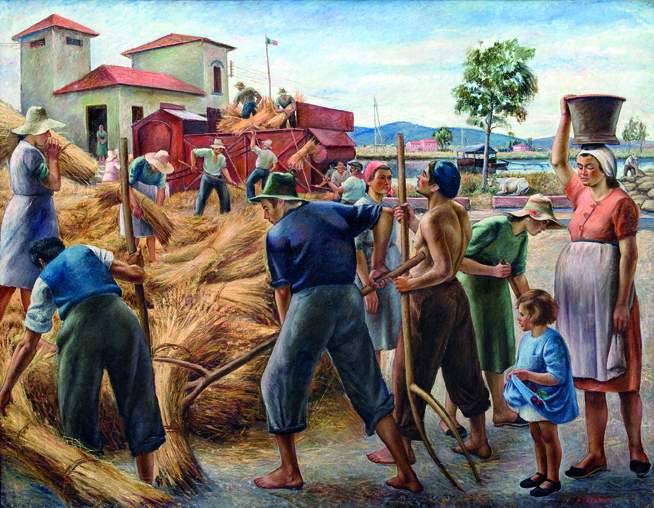In Grosseto, Il grano della bonifica lucchese, the large painting on canvas (measuring 233 by 300 centimeters) that Tuscan painter Alfredo Catarsini (Viareggio, 1899 - 1993) made in 1940 to participate in the second of three editions of the Cremona Prize, among the most important kermesse for young artists from all over Italy that took place between 1939 and 1941 in the Lombard capital, has been tracked down and will soon be visible to all. The discovery came about thanks to the interest of an antiquarian from Grosseto, Maurizio Ticci, who had acquired it for his personal collection after the exhibition at the Palazzo Mediceo in Seravezza entitled “Sharecropping in Tuscany. Culture of the Land in Tuscany. Mezzadri e coltivatori diretti nell’arte dell’Ottocento e del Novecento” held from July 4 to September 29, 2009, curated by Andrea Baldinotti and Enrico Dei.
Despite its considerable size and fame even abroad, traces of the work had been lost just after the exhibition twelve years ago, but the major campaign to search for Alfredo Catarsini’s off-circuit works for inclusion in the general catalog underway launched last Sept. 23 through all the channels of the Catarsini Foundation has borne fruit.
Catarsini’s large painting will finally be back on public view during a series of consecutive appointments organized for the occasion: from Monday, Jan. 3 (with vernissage at 4 p.m.) until Wednesday, Jan. 12, one can admire The Grain of the Reclamation of Lucca in the Grosseto gallery of antiquarian Ticci (Monday through Saturday, 4-8 p.m., free admission). Then, from Monday, Jan. 17, Catarsini’s birthday, the work will be on display at the Gallery of Modern and Contemporary Art (Gamc) in Viareggio (Wednesday through Saturday, 3:30-7:30 p.m.; Sunday 9:30 a.m.-1:30 p.m. and 3:30-7 p.m:30; admission € 8, concessions € 4), where the nucleus of some 30 works by Catarsini donated in 2002 to the City of Viareggio by his children Mity and Orazio is kept (though not on display), while the faithful reconstruction and archive of Alfredo Catarsini can be seen at Villa museo Paolina Bonaparte. An official presentation will be organized for the occasion at Gamc by the Viareggio City Council’s Department of Culture. The large painting will remain at Gamc until March 2022, when it will be temporarily moved to Lucca for the major spring exhibition dedicated to Catarsini’s painting of the 1930s and 1940s.

The Grainof the Lucchese Rec lamation appears in a photo depicting the painter during its making: that photo, which unwittingly became the “clue” to a research for years, was published in the volume Alfredo Catarsini. True Art Fascinating Friend, edited by Elena Martinelli and Claudia Menichini, presented last summer at the Versiliana by Vittorio Sgarbi and Cristina Acidini. On that occasion it was precisely the Ferrara-based art critic who pointed out Catarsini as one of the Italian painters, among those who participated in the three editions of the “Cremona Prize,” to be most valued because they represent a strongly innovative art.
Professor Rodolfo Bona wrote in the painting’s entry, “The second Cremona Prize was held from May 19 to July 21, 1940. The Grain of Lucca Reclamation was painted between 1939 and the end of April 1940 and is signed at lower right ’A. Catarsini’. Recovering from his success at the first edition of the Cremona Prize in 1939, the following year the painter sent the painting The Grain of the Lucchese Reclamation to Palazzo Affaitati in Cremona. The exhibition was dedicated to La Battaglia del grano (The Battle of the Grain), and although it did not win any prizes, the painting was appreciated both in Italy and at the Künstlerhaus in Hannover, where it was exhibited the same year among 69 paintings carefully selected from among the lesser known to the German public, as part of the cultural twinning with the Lower Saxony city. In more recent years it has reappeared in Seravezza, as part of an exhibition dedicated to agricultural work, and, perfectly preserved, it now perfectly allows us to appreciate the painter’s pictorial draftsmanship and color choices, characterized by a clear and luminous painting that becomes more solid in the closer planes to become lighter in the background. Recently acquired by the Catarsini Foundation as part of a broader recovery of the painter’s output, it can now be seen again by the public. Of the three works that Catarsini submitted to the Cremona Prize, The Grain of the Lucchese Reclamation is the only one tracked down, reflecting the general dispersion of the paintings that competed for the Cremona Prize between 1939 and 1941 and the importance of the reappearance of the work’s acquisition.”
ra that the work is in the full availability of the Alfredo Catarsini 1899 Foundation, after the double preview in Grosseto and Viareggio, President Elena Martinelli has already planned to send it to Lucca for a major exhibition on the artist from Viareggio that will be curated by Bona himself in the spring. An important piece of the Viareggio painter’s production thus returns to its place, allowing everyone to better understand his artistic parabola.
 |
| Tracked down important painting by Alfredo Catarsini that had been lost track of |
Warning: the translation into English of the original Italian article was created using automatic tools. We undertake to review all articles, but we do not guarantee the total absence of inaccuracies in the translation due to the program. You can find the original by clicking on the ITA button. If you find any mistake,please contact us.